机器学习十大算法8:kNN
机器学习之KNN(K最近邻算法)
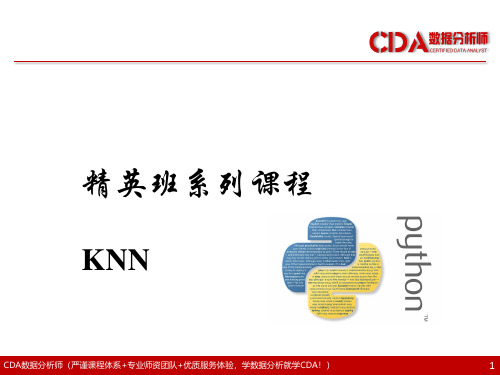
21
CDA数据分析师(严谨课程体系+专业师资团队+优质服务体验,学数据分析就学CDA!)
22
CDA数据分析师(严谨课程体系+专业师资团队+优质服务体验,学数据分析就学CDA!)
11
KNN
◼ 判决过程:
✓ k取3,按距离依次排序的三个点分别是动作片(108,5)、动作片 (115,8)、爱情片(5,89)。在这三个点中,动作片出现的频率为三分 之二,爱情片出现的频率为三分之一,所以该红色圆点标记的电影 为动作片。这个判别过程就是k-近邻算法
精英班系列课程
KNN
CDA数据分析师(严谨课程体系+专业师资团队+优质服务体验,学数据分析就学CDA!)
1
KNN
◼ K最近邻(kNN,k-Nearest Neighbor):
✓ k近邻法(k-nearest neighbor, k-NN)是1967年由Cover T和Hart P 提出的一种基本分类与回归方法。K最近邻分类算法是数据挖掘分类 技术中最简单的方法之一。所谓K最近邻,就是k个最近的邻居的意 思,每个样本都可以用它最接近的k个邻居来代表
CDA数据分析师(严谨课程体系+专业师资团队+优质服务体验,学数据分析就学CDA!)
13
KNN
◼ k-近邻算法代码实现电影分类
CDA数据分析师(严谨课程体系+专业师资团队+优质服务体验,学数据分析就学CDA!)
14
KNN
◼ k-近邻算法实战:约会网站配对效果判定
✓ 海伦女士一直使用在线约会网站寻找适合自己的约会对象。尽管约 会网站会推荐不同的人选,但她并不是喜欢每一个人。经过一番总 结,她发现自己交往过的人可以进行如下分类: • 不喜欢的人 • 魅力一般的人 • 极具魅力的人
大数据十大经典算法kNN讲解

可解释性差
KNN算法的分类结果只依赖于最近 邻的样本,缺乏可解释性。
无法处理高维数据
随着维度的增加,数据点之间的距离 计算变得复杂,KNN算法在高维空 间中的性能会受到影响。
对参数选择敏感
KNN算法中需要选择合适的K值,不 同的K值可能会影响分类结果。
04
KNN算法的改进与优化
基于距离度量的优化
与神经网络算法的比较
神经网络算法
神经网络算法是一种监督学习算法,通过训练神经元之间的权重来学习数据的内 在规律。神经网络算法在处理大数据集时需要大量的计算资源和时间,因为它的 训练过程涉及到复杂的迭代和优化。
KNN算法
KNN算法的训练过程相对简单,不需要进行复杂的迭代和优化。此外,KNN算 法对于数据的分布和规模不敏感,因此在处理不同规模和分布的数据集时具有较 好的鲁棒性。
对数据分布不敏感
KNN算法对数据的分布不敏感, 因此对于非线性问题也有较好 的分类效果。
简单直观
KNN算法原理简单,实现直观, 易于理解。
分类准确度高
基于实例的学习通常比基于规 则或判别式的学习更为准确。
对异常值不敏感
由于KNN基于实例的学习方式, 异常值对分类结果影响较小。
缺点
计算量大
KNN算法需要计算样本与所有数据 点之间的距离,因此在大规模数据集 上计算量较大。
欧氏距离
适用于数据特征呈正态分布的情况,但在非 线性可分数据上表现不佳。
余弦相似度
适用于高维稀疏数据,能够处理非线性可分 问题。
曼哈顿距离
适用于网格结构的数据,但在高维数据上计 算量大。
皮尔逊相关系数
适用于衡量两组数据之间的线性关系。
K值选择策略的优化
KNN(k近邻)机器学习算法详解

KNN(k近邻)机器学习算法详解KNN算法详解一、算法概述1、kNN算法又称为k近邻分类(k-nearest neighbor classification)算法。
最简单平凡的分类器也许是那种死记硬背式的分类器,记住所有的训练数据,对于新的数据则直接和训练数据匹配,如果存在相同属性的训练数据,则直接用它的分类来作为新数据的分类。
这种方式有一个明显的缺点,那就是很可能无法找到完全匹配的训练记录。
kNN算法则是从训练集中找到和新数据最接近的k条记录,然后根据他们的主要分类来决定新数据的类别。
该算法涉及3个主要因素:训练集、距离或相似的衡量、k的大小。
2、代表论文Discriminant Adaptive Nearest Neighbor ClassificationTrevor Hastie and Rolbert Tibshirani3、行业应用客户流失预测、欺诈侦测等(更适合于稀有事件的分类问题)二、算法要点1、指导思想kNN算法的指导思想是“近朱者赤,近墨者黑”,由你的邻居来推断出你的类别。
计算步骤如下:1)算距离:给定测试对象,计算它与训练集中的每个对象的距离?2)找邻居:圈定距离最近的k个训练对象,作为测试对象的近邻?3)做分类:根据这k个近邻归属的主要类别,来对测试对象分类2、距离或相似度的衡量什么是合适的距离衡量?距离越近应该意味着这两个点属于一个分类的可能性越大。
觉的距离衡量包括欧式距离、夹角余弦等。
对于文本分类来说,使用余弦(cosine)来计算相似度就比欧式(Euclidean)距离更合适。
3、类别的判定投票决定:少数服从多数,近邻中哪个类别的点最多就分为该类。
加权投票法:根据距离的远近,对近邻的投票进行加权,距离越近则权重越大(权重为距离平方的倒数)三、优缺点简单,易于理解,易于实现,无需估计参数,无需训练适合对稀有事件进行分类(例如当流失率很低时,比如低于0.5%,构造流失预测模型)特别适合于多分类问题(multi-modal,对象具有多个类别标签),例如根据基因特征来判断其功能分类,kNN比SVM的表现要好懒惰算法,对测试样本分类时的计算量大,内存开销大,评分慢可解释性较差,无法给出决策树那样的规则。
knn 算法
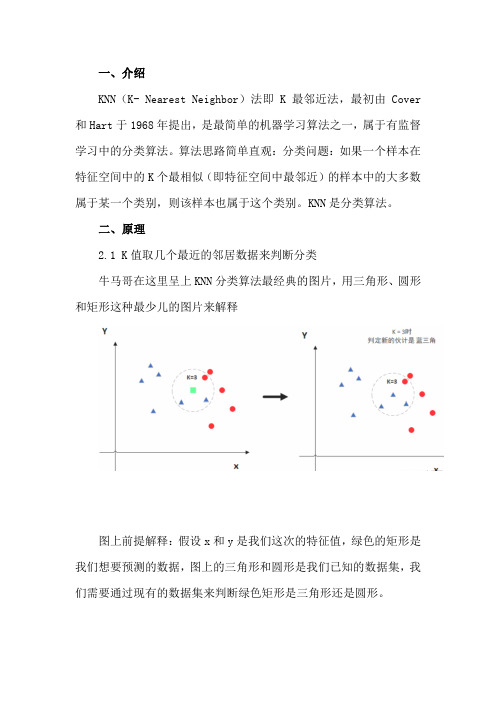
一、介绍KNN(K- Nearest Neighbor)法即K最邻近法,最初由 Cover 和Hart于1968年提出,是最简单的机器学习算法之一,属于有监督学习中的分类算法。
算法思路简单直观:分类问题:如果一个样本在特征空间中的K个最相似(即特征空间中最邻近)的样本中的大多数属于某一个类别,则该样本也属于这个类别。
KNN是分类算法。
二、原理2.1 K值取几个最近的邻居数据来判断分类牛马哥在这里呈上KNN分类算法最经典的图片,用三角形、圆形和矩形这种最少儿的图片来解释图上前提解释:假设x和y是我们这次的特征值,绿色的矩形是我们想要预测的数据,图上的三角形和圆形是我们已知的数据集,我们需要通过现有的数据集来判断绿色矩形是三角形还是圆形。
当K = 3,代表选择离绿色矩形最近的三个数据,发现三个数据中三角形比较多,所以矩形被分类为三角形当K = 5,代表选择离绿色矩形最近的三个数据,发现五个数据中圆形最多,所以矩形被分类为圆形所以K值很关键,同时建议k值选取奇数。
2.2 距离问题在上面的原理中还有一个关键问题,就是怎么判断距离是否最近。
在这里采用的是欧式距离计算法:下图是在二维的平面来计算的,可以当作是有两个特征值那如果遇到多特征值的时候,KNN算法也是用欧式距离,公式如下:从这里就能看出KNN的问题了,需要大量的存储空间来存放数据,在高维度(很多特征值输入)使用距离的度量算法,电脑得炸哈哈,就是极其影响性能(维数灾难)。
而且如果要预测的样本数据偏离,会导致分类失败。
优点也是有的,如数据没有假设,准确度高,对异常点不敏感;理论成熟,思想简单。
三.KNN特点KNN是一种非参的,惰性的算法模型。
什么是非参,什么是惰性呢?非参的意思并不是说这个算法不需要参数,而是意味着这个模型不会对数据做出任何的假设,与之相对的是线性回归(我们总会假设线性回归是一条直线)。
也就是说KNN建立的模型结构是根据数据来决定的,这也比较符合现实的情况,毕竟在现实中的情况往往与理论上的假设是不相符的。
人工智能技术常用算法

人工智能技术常用算法
一、机器学习算法
1、数据类:
(1)K最近邻算法(KNN):KNN算法是机器学习里最简单的分类算法,它将每个样本都当作一个特征,基于空间原理,计算样本与样本之间的距离,从而进行分类。
(2)朴素贝叶斯算法(Naive Bayes):朴素贝叶斯算法是依据贝叶斯定理以及特征条件独立假设来计算各类别概率的,是一种贝叶斯决策理论的经典算法。
(3)决策树(Decision Tree):决策树是一种基于条件概率知识的分类和回归模型,用通俗的话来讲,就是基于给定的数据,通过计算出最优的属性,构建一棵树,从而做出判断的过程。
2、聚类算法:
(1)K-means:K-means算法是机器学习里最经典的聚类算法,它会将相似的样本分到一起,从而实现聚类的目的。
(2)层次聚类(Hierarchical clustering):层次聚类是一种使用组织树(层次结构)来表示数据集和类之间关系的聚类算法。
(3)谱系聚类(Spectral clustering):谱系聚类算法是指,以频谱图(spectral graph)来表示数据点之间的相互关系,然后将数据点聚类的算法。
三、深度学习算法
1、卷积神经网络(Convolutional Neural Network):卷积神经网络是一种深度学习算法。
knn算法的例子

knn算法的例子k-最近邻算法(k-nearest neighbors,简称k-NN)是一种常用的分类和回归算法。
它基于一个简单的假设:如果一个样本的k个最近邻属于某个类别,那么该样本也很可能属于该类别。
k-NN算法非常直观和易于理解,因此被广泛应用于各种领域。
下面将以几个具体的例子来说明k-NN算法的应用。
1. 手写数字识别在机器学习领域,手写数字识别是一个经典的问题。
k-NN算法可以用于将手写数字图片分类成0到9之间的数字。
基于已有的数字图片数据集,可以计算待分类图片与每个已有图片的距离,并找出k 个最近邻。
然后根据这k个最近邻的标签来判断待分类图片的数字。
2. 电影推荐系统在电影推荐系统中,k-NN算法可以根据用户的历史评分和其他用户的评分来预测用户可能喜欢的电影。
通过计算待推荐电影与用户历史评分电影的相似度,找出k个最相似的电影,并根据这些电影的评分来预测用户对待推荐电影的评分。
3. 股票市场预测k-NN算法可以用于预测股票市场的趋势。
基于已有的股票数据,可以计算待预测股票与历史股票的相似度,并找出k个最相似的股票。
然后根据这k个股票的涨跌情况来预测待预测股票的涨跌。
4. 医学诊断在医学诊断中,k-NN算法可以帮助医生根据患者的各项指标来预测患有哪种疾病。
通过计算待预测患者与已有患者的相似度,找出k 个最相似的患者,并根据这些患者的疾病情况来预测待预测患者的疾病。
5. 文本分类k-NN算法可以用于文本分类,例如将新闻文章分类成不同的主题。
基于已有的训练数据,可以计算待分类文本与每个已有文本的相似度,并找出k个最相似的文本。
然后根据这k个文本的主题来预测待分类文本的主题。
6. 信用评估在信用评估中,k-NN算法可以用于预测申请贷款的人是否具有良好的信用记录。
通过计算待评估人员与已有人员的相似度,找出k个最相似的人员,并根据这些人员的信用记录来预测待评估人员的信用状况。
7. 图像处理k-NN算法可以用于图像处理,例如图像分类和图像检索。
knn算法原理

knn算法原理KNN(K近邻算法)是一种基于实例的机器学习算法,是机器学习领域中非常常见的算法。
KNN法的基本思想是:如果一个样本在特征空间中的k个最相近的样本中的大多数属于某一个类别,则该样本也属于该类别。
KNN法中,所选择的邻居都是已经正确分类的对象。
KNN法的基本原理是:在给定一个未知类别的对象(样本数据)时,根据其特征属性和它最接近的K个已经知道分类的样本,对这个对象进行分类。
KNN法就是从训练集中找出这K个“邻居”,根据这K 个“邻居”的类别,来确定当前未知类别的对象的分类。
KNN法的基本流程如下:1. 从训练集中计算测试实例与每个训练集实例之间的距离;2.据距离选择K个最近邻;3.据K个邻居的类别,通过投票或者加权求和,确定测试实例的类别。
KNN法使用数据中“靠近”的训练实例来预测未知实例,因此,KNN法是一种基于实例的学习算法。
KNN法的实质是在训练集中查找与当前输入实例最在的 K 个实例,并将它们的“类标记”作为对应的输入实例的预测。
KNN法的优点是:1. KNN法的思想简单,实现容易,它不需要学习过程,也不需要假设数据的分布,只需要保存所有数据实例;2.实际数据建模时,可以有效地处理属性间关系比较复杂和数据不平衡的情况;3. KNN法可以灵活地处理不同的数据类型。
KNN法也存在一些缺点:1. KNN法需要大量的计算,当训练数据集特别大的时候,搜索K 个最近邻计算量就比较大,可能会耗费较多的时间;2. KNN法的效果依赖于k的值,但是k的值没有一个理论上的确定方法,只能选取不同的k值进行实验;3. KNN法不能很好地处理类别不平衡问题,因为它采用的算法是加权求和,类别不平衡的情况下,加权求和会倾向于那些比较多的类别;4. KNN法的思想是当前的数据点的类别取决于它的K个邻居,而这里的K个邻居都是已经被正确分类的,即每个邻居都是“正确”的,这种认为是不合理的,因为它假定K个邻居的类别都被正确分类了,而这并不一定是真的。
机器学习算法模型——K近邻法(KNN)

机器学习算法模型——K近邻法(KNN)1、基本概念K近邻法(K-nearest neighbors,KNN)既可以分类,也可以回归。
KNN做回归和分类的区别在于最后预测时的决策⽅式。
KNN做分类时,⼀般⽤多数表决法KNN做回归时,⼀般⽤平均法。
基本概念如下:对待测实例,在训练数据集中找到与该实例最邻近的K个实例(也就是上⾯所说的K个邻居),这K个实例的多数属于某个类,就把该输⼊实例分类到这个类中2. KNN算法三要素 KNN算法主要考虑:k值的选取,距离度量⽅式,分类决策规则。
1) k值的选取。
在应⽤中,k值⼀般选择⼀个⽐较⼩的值,⼀般选⽤交叉验证来取最优的k值当K值较⼩,训练误差减⼩,泛化误差增⼤,模型复杂容易过拟合;当K值较⼤,泛化误差减⼩,训练误差增⼤,模型简单使预测发⽣错误(⼀个极端,K等于样本数m,则完全没有分类,此时⽆论测试集是什么,结果都属于训练集中最多的类) 2)距离度量。
Lp距离:误差绝对值p次⽅求和再求p次根。
欧式距离:p=2的Lp距离。
曼哈顿距离:p=1的Lp距离。
p为⽆穷⼤时,Lp距离为各个维度上距离的最⼤值 3)分类决策规则。
也就是如何根据k个最近邻决定待测对象的分类。
k最近邻的分类决策规则⼀般选⽤多数表决3. KNN基本执⾏步骤 1)计算待测对象和训练集中每个样本点的欧式距离 2)对上⾯的所有距离值排序 3)选出k个最⼩距离的样本作为“选民” 4)根据“选民”预测待测样本的分类或值4. KNN特点 1)原理简单 2)保存模型需要保存所有样本集 3)训练过程很快,预测速度很慢· 优点: 精度⾼、对异常值不敏感 可⽤于数值型数据和离散型数据(既可以⽤来估值,⼜可以⽤来分类)· 缺点: 时间复杂性⾼;空间复杂性⾼;需要⼤量的内存 样本不平衡问题(即有些类别的样本数量很多,⽽其它样本的数量很少); ⼀般数值很⼤的时候不⽤这个,计算量太⼤。
但是单个样本⼜不能太少,否则容易发⽣误分。
KNN算法 - 机器学习算法入门
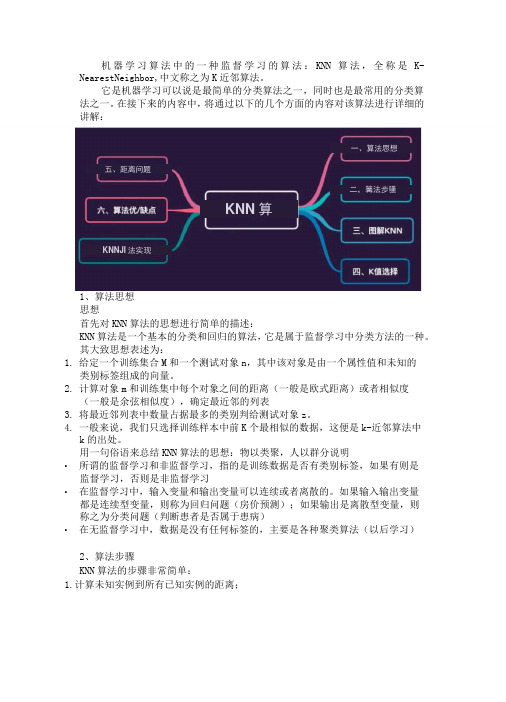
机器学习算法中的一种监督学习的算法:KNN算法,全称是K-NearestNeighbor,中文称之为K近邻算法。
它是机器学习可以说是最简单的分类算法之一,同时也是最常用的分类算法之一。
在接下来的内容中,将通过以下的几个方面的内容对该算法进行详细的讲解:一、算法思想五、距离问题二,篝法步骚KNN算KNNJI法实现1、算法思想思想首先对KNN算法的思想进行简单的描述:KNN算法是一个基本的分类和回归的算法,它是属于监督学习中分类方法的一种。
其大致思想表述为:1.给定一个训练集合M和一个测试对象n,其中该对象是由一个属性值和未知的类别标签组成的向量。
2.计算对象m和训练集中每个对象之间的距离(一般是欧式距离)或者相似度(一般是余弦相似度),确定最近邻的列表3.将最近邻列表中数量占据最多的类别判给测试对象z。
4.一般来说,我们只选择训练样本中前K个最相似的数据,这便是k-近邻算法中k的出处。
用一句俗语来总结KNN算法的思想:物以类聚,人以群分说明•所谓的监督学习和非监督学习,指的是训练数据是否有类别标签,如果有则是监督学习,否则是非监督学习•在监督学习中,输入变量和输出变量可以连续或者离散的。
如果输入输出变量都是连续型变量,则称为回归问题(房价预测);如果输出是离散型变量,则称之为分类问题(判断患者是否属于患病)•在无监督学习中,数据是没有任何标签的,主要是各种聚类算法(以后学习)2、算法步骤KNN算法的步骤非常简单:1.计算未知实例到所有已知实例的距离;2.选择参数K(下面会具体讲解K值的相关问题)3.根据多数表决(Majority-Voting)规则,将未知实例归类为样本中最多数的类别3、图解KNN算法K值影响下面通过一组图形来解释下KNN算法的思想。
我们的目的是:判断蓝色的点属于哪个类别我们通过变化K的取值来进行判断。
在该算法中K的取值一般是奇数,防止两个类别的个数相同,无法判断对象的类别K=1、3、5、7…….1.首先如果K=1:会是什么的情况?根据图形判断:蓝色图形应该是属于三角形2.K=3的情形从图中可以看出来:蓝色部分还是属于三角形3.K=5的情形:此时我们观察到蓝色部分属于正方形了4.K=7的情形:这个时候蓝色部分又变成了三角形小结当K取值不同的时候,判别的结果是不同的。
机器学习中的KNN算法及应用
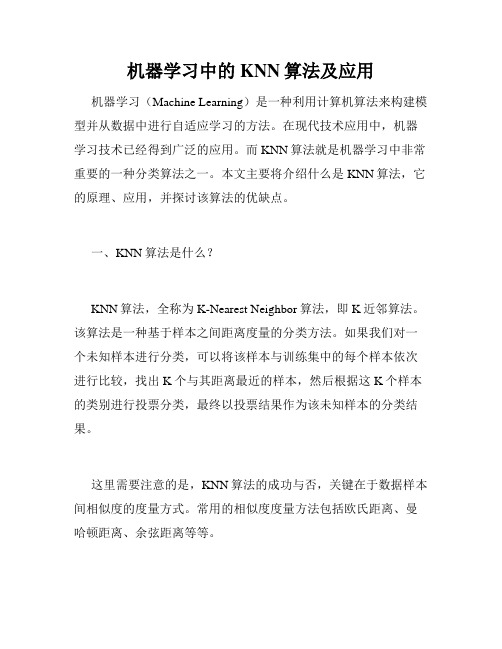
机器学习中的KNN算法及应用机器学习(Machine Learning)是一种利用计算机算法来构建模型并从数据中进行自适应学习的方法。
在现代技术应用中,机器学习技术已经得到广泛的应用。
而KNN算法就是机器学习中非常重要的一种分类算法之一。
本文主要将介绍什么是KNN算法,它的原理、应用,并探讨该算法的优缺点。
一、KNN算法是什么?KNN算法,全称为K-Nearest Neighbor算法,即K近邻算法。
该算法是一种基于样本之间距离度量的分类方法。
如果我们对一个未知样本进行分类,可以将该样本与训练集中的每个样本依次进行比较,找出K个与其距离最近的样本,然后根据这K个样本的类别进行投票分类,最终以投票结果作为该未知样本的分类结果。
这里需要注意的是,KNN算法的成功与否,关键在于数据样本间相似度的度量方式。
常用的相似度度量方法包括欧氏距离、曼哈顿距离、余弦距离等等。
二、KNN算法的原理KNN算法是一种非参数算法,它不依赖于数据分布的先验假设。
该算法的基本思想是在一个样本空间中,将离某个未知样本点最近的K个样本点作为该未知样本的最近邻进行分类。
其具体步骤如下:1、准备数据集,将数据按照一定的规则进行标准化处理;2、根据所选定的相似度度量方法计算未知样本与每个训练集样本的距离;3、将得到的距离按照从小到大排序,在距离最近的K个样本中按照一定的规则进行投票分类,得到最终分类结果。
三、KNN算法的应用KNN算法在分类问题中得到了广泛应用。
通常,我们需要将数据集分为训练数据集和测试数据集来验证KNN算法的正确性。
例如,在图像识别领域,KNN算法可以识别数字或字母的形状,从而实现自动识别和分类。
再比如,在医学诊断中,KNN算法可以根据患者的病症和主要特征,帮助医生诊断疾病。
此外,KNN算法还可用于推荐系统、电子商务、金融风控等方面。
四、KNN算法的优缺点KNN算法的优点是简单易懂,易于实现,不需要训练和调参,在某些简单的分类问题中,它可以实现高精度的分类。
机器学习十大算法8:kNN概要

Chapter8k NN:k-Nearest NeighborsMichael Steinbach and Pang-Ning TanContents8.1Introduction (1518.2Description of the Algorithm (1528.2.1High-Level Description (1528.2.2Issues (1538.2.3Software Implementations (1558.3Examples (1558.4Advanced Topics (1578.5Exercises (158Acknowledgments (159References (1598.1IntroductionOne of the simplest and rather trivial classifiers is the Rote classifier,which memorizes the entire training data and performs classification only if the attributes of the test object exactly match the attributes of one of the training objects.An obvious problem with this approach is that many test records will not be classified because they do notexactly match any of the training records.Another issue arises when two or more training records have the same attributes but different class labels.A more sophisticated approach,k-nearest neighbor(kNNclassification[10,11,21],finds a group of k objects in the training set that are closest to the test object,and bases the assignment of a label on the predominance of a particular class in this neighborhood.This addresses the issue that,in many data sets,it is unlikely that one object will exactly match another,as well as the fact that conflicting information about the class of an object may be provided by the objects closest to it.There are several key elements of this approach:(ithe set of labeled objects to be used for evaluating a test object’s class,1(iia distance or similarity metric that can be used to computeThis need not be the entire training set.151152kNN:k-Nearest Neighborsthe closeness of objects,(iiithe value of k,the number of nearest neighbors,and(iv the method used to determine the class of the target object based on the classes and distances of the k nearest neighbors.In its simplest form,k NN can involve assigning an object the class of its nearest neighbor or of the majority of its nearest neighbors, but a variety of enhancements are possible and are discussed below.More generally,k NN is a special case of instance-based learning[1].This includes case-based reasoning[3],which deals with symbolic data.The k NN approach is also an example of a lazy learning technique,that is,a technique that waits until the query arrives to generalize beyond the training data.Although k NN cl assification is a classification technique that is easy to understand and implement,it performs well in many situations.In particular,a well-known result by Cover and Hart[6]shows that the classification error2of the nearest neighbor rule isbounded above by twice the optimal Bayes error3under certain reasonable assump-tions.Furthermore,the error of the general k NN method asymptotically approaches that of the Bayes error and can be used to approximate it.Also,because of its simplicity,k NN is easy to modify for more complicated classifi-cation problems.For instance,k NN is particularly well-suited for multimodal classes4 as well as applications in which an object can have many class labels.To illustrate the last point,for the assignment of functions to genes based on microarray expressionprofiles,some researchers found that k NN outperformed a support vector machine (SVMapproach,which is a much more sophisticated classification scheme[17]. The remainder of this chapter describes the basic k NN algorithm,including vari-ous issues that affect both classification and computational performance.Pointers are given to implementations of k NN,and examples of using the Weka machine learn-ing package to perform nearest neighbor classification are also provided.Advanced techn iques are discussed briefly and this chapter concludes with a few exercises. 8.2Description of the Algorithm8.2.1High-Level DescriptionAlgorithm8.1provides a high-level summary of the nearest-neighbor classification method.Given a training set D and a test object z,which is a vector of attribute values and has an unknown class label,the algorithm computes the distance(or similarity2The classification error of a classifier is the percentage of instances it incorrectly classifies.3The Bayes error is the classification error of a Bayes classifier,that is,a classifier that knows the underlying probability distribution of the data with respect to class,and assigns each data point to the class with the highest probability density for that point.For more detail,see[9].4With multimodal classes,objects of a particular class label are concentrated in several distinct areas of the data space,not just one.In statistical terms,the probability density function for the class does not have a single“bump”like a Gaussian,but rath er,has a number of peaks.8.2Description of the Algorithm 153Algorithm 8.1Basic k NN AlgorithmInput :D ,the set of training objects,the test object,z ,which is a vector ofattribute values,and L ,the set of classes used to label the objectsOutput :c z ∈L ,the class of z foreach object y ∈D do|Compute d (z ,y ,the distance between z and y ;endSelect N ⊆D ,the set (neighborhoodof k closest training objects for z ;c z =argmax v ∈Ly ∈N I (v =class (c y ;where I (·is an indicator function that returns the value 1if its argument is true and 0otherwise.between z and all the training objects to determine its nearest-neighbor list.It then assigns a class to z by taking the class of the majority of neighboring objects.Ties are broken in an unspecified manner,for example,randomly or by taking the most frequent class in the training set.The storage complexity of the algorithm is O (n ,where n is the number of training objects.The time complexity is also O (n ,since the distance needs to be computed between the target and each training object.However,there is no time taken for the construction of the classification model,for example,a decision tree or sepa-rating hyperplane.Thus,k NN is different from most other classification techniques which have moderately to quite expensive model-building stages,but very inexpensive O (constant classification steps.8.2.2IssuesThere are several key issues that affect the performance of k NN.One is the choice of k .This is illustrated in Figure 8.1,which shows an unlabeled test object,x ,and training objects that belong to either a “+”or “−”class.If k is too small,then the result can be sensitive to noise points.On the other hand,if k is too large,then the neighborhood may include too many points from other classes.An estimate of the best value for k can be obtained by cross-validation.However,it is important to point out that k =1may be able to perform other values of k ,particularly for small data sets,including those typically used in research or for class exercises.However,given enough samples,larger values of k are more resistant to noise.Another issue is the approach to combining the class labels.The simplest method is to take a majority vote,but this can be a problem if the nearest neighbors vary widely in their distance and the closer neighbors more reliably indicate the class of the object.A more sophisticated approach,which is usually much less sensitive to the choice ofk ,weights each object’s vote by its distance.Various choices are possible;for example,the weight factor is often taken to be the reciprocal of the squared distance:w i =1/d (y ,z 2.This amounts to replacing the last step of Algorithm 8.1with the154kNN:k-Nearest Neighbors ++‒‒‒‒‒‒‒‒‒‒‒‒‒‒‒‒‒‒‒‒+++X ++++++‒‒‒‒‒‒‒‒‒‒‒‒‒‒‒‒‒‒‒‒‒+++++++++++X ‒‒‒‒‒‒‒‒‒‒‒‒‒‒‒‒‒‒‒‒‒+++++++++++X (a Neighborhood toosmall.(b Neighborhood just right.(c Neighborhood too large.Figure 8.1k -nearest neighbor classification with small,medium,and largek .following:Distance-Weighted V oting:c z =argmax v ∈L y ∈N w i ×I (v =class (c y (8.1The choice of the distance measure is another importantmonly,Euclidean or Manhattan distance measures are used [21].For two points,x and y ,with n attributes,these distances are given by the following formulas:d (x ,y = n k =1(x k −y k 2Euclidean distance (8.2d (x ,y = n k =1|x k −y k |Manhattan distance (8.3where x k and y k are the k th attributes (componentsof x and y ,respectively.Although these and various other measures can be used to compute the distance between two points,conceptually,the most desirable distance measure iswhich a smaller distance between two objects implies a greater likelihood the same class.Thus,for example,if k NN is being applied to classify it may be better to use the cosine measure rather than Euclidean distance.k NN can also be used for data with categorical or mixed categorical and numerical attributes as long as a suitable distance measure can be defined [21].Some distance measures can also be affected by the high dimensionality of the data.In particular,it is well known that the Euclidean distance measure becomes less discriminating as the number of attributes increases.Also,attributes may have to be scaled to prevent distance measures from being dominated by one of the attributes.For example,consider a data set where the height of a person varies from 1.5to 1.8m,8.3Examples155 the weight of a person varies from90to300lb,and the income of a person varies from$10,000to$1,000,000.If a distance measure is used without scaling,the income attribute will dominate the computation of distance,and thus the assignment of class labels.8.2.3Software ImplementationsAlgorithm8.1is easy to implement in almost any programming language.However, this section contains a short guide to some readily available implementations of this algorithm and its variants for those who would rather use an existing implementation. One of the most readily available k NN implementations can be found in Weka[26]. The main function of interest is IBk,which is basically Algorithm8.1.However,IBk also allows you to specify a couple of choices of distance weighting and the option to determine a value of k by using cross-validation.Another popular nearest neighbor implementation is PEBLS(Parallel Exemplar-Based Learning System[5,19]from the CMU Artificial Intelligence repository[20]. According to the site,“PEBLS(Parallel Exemplar-Based Learning Systemis a nearest-neighbor learning system designed for applications where the instances have symbolic feature values.”8.3ExamplesIn this section we provide a couple of examples of the use of k NN.For these examples, we will use the Weka package described in the previoussection.Specifically,we used Weka3.5.6.To begin,we applied k NN to the Iris data set that is available from the UCI Machine Lear ning Repository[2]and is also available as a sample datafile with Weka.This data set consists of150flowers split equally among three Iris species:Setosa,Versicolor, and Virginica.Eachflower is characterized by four measurements:petal length,petalwidth,sepal length,and sepal width.The Iris data set was classified using the IB1algorithm,which corresponds to the IBk algorithm with k=1.In other words,the algorithm looks at the closest neighbor, as computed using Euclidean distance from Equation8.2.The results are quite good, as the reader can see by examining the confusion matrix5given in Table8.1. However,further investigation shows that this is a quite easy data set to classify since the different species are relatively well separated in the data space.To illustrate, we show a plot of the data with respect to petal length and petal width in Figure8.2. There is some mixing between the Versicolor and Virginica species with respect to 5A confusion matrix tabulates how the actual classes of various data instances(rowscompare to their predictedclasses(columns.156kNN:k-Nearest NeighborsTABLE 8.1Confusion Matrix for Weka k NNClassifier IB1on the Iris Data SetActual/Predicted Setosa Versicolor Virginica Setosa5000Versicolor0473Virginica 0446their petal lengths and widths,but otherwise the species are well separated.Since the other two variables,sepal width and sepal length,add little if any discriminating information,the performance seen with basic k NN approach is about the best that can be achieved with a k NN approach or,indeed,any other approach.The second example uses the ionosphere data set from UCI.The data objects in this data set are radar signals sent into the ionosphere and the class value indicates whether or not the signal returned information on the structure of the ionosphere.There are34attributes that describe the signal and 1class attribute.The IB1algorithm applied on the original data set gives an accuracy of 86.3%evaluated via tenfold cross-validation,while the same algorithm applied to the first nine attributes gives an accuracy of 89.4%.In other words,using fewer attributes gives better results.The confusion matrices are given ing cross-validation to select the number of nearest neighbors gives an accuracy of 90.8%with two nearest neighbors.The confusion matrices for these cases are given below in Tables 8.2,8.3,and 8.4,respectively.Adding weighting for nearest neighbors actually results in a modest drop in accuracy.The biggest improvement is due to reducing the number of attributes.P e t a l w i d t h Petal lengthFigure 8.2Plot of Iris data using petal length and width.8.4Advanced Topics157TABLE8.2Confusion Matrix for Weka k NN ClassifierIB1on the Ionosphere Data Set Using All AttributesActual/Predicted Good Signal Bad SignalGood Signal8541Bad Signal72188.4Advanced TopicsTo address issues related to the distance function,a number of schemes have been developed that try to compute the weights of each individual attribute or in some other way determine a more effective distance metric based upon a training set[13,15]. In addition,weights can be assigned to the training objects themselves.This can give more weight to highly reliable training objects,while reducing the impact of unreliable objects.The PEBLS system by Cost and Salzberg[5]is a well-known example of such an approach.As mentioned,k NN classifiers are lazy learners,that is,models are not built explic-itly unlike eager learners(e.g.,decision trees,SVM,etc..Thus,building the model is cheap,but classifying unknown objects is relatively expensive since it requires the computation of the k-nearest neighbors of the object to be labeled.This,in general, requires computing the distance of the unlabeled object to all the objects in the la-beled set,which can be expensive particularly for large training sets.A number of techniques,e.g.,multidimensional access methods[12]or fast approximate similar-ity search[16],have been developed for efficient computation of k-nearest neighbor distance that make use of the structure in the data to avoid having to compute distance to allobjects in the training set.These techniques,which are particularly applicable for low dimensional data,can help reduce the computational cost without affecting classification accuracy.The Weka package provides a choice of some of the multi-dimensional access methods in its IBk routine.(See Exercise4.Although the basic k NN algorithm and some of its variations,such as weighted k NN and assigning weights to objects,are relatively well known,some of the more advanced techniques for k NN are much less known.For example,it is typically possible to eliminate many of the stored data objects,but still retain the classification accuracy of the k NN classifier.This is known as“condensing”and can greatly speed up theclassification o f new objects[14].In addition,data objects can be removed toTABLE8.3Confusion Matrix for Weka k NN ClassifierIB1on the Ionosphere Data Set Using the First Nine AttributesActual/Predicted Good Signal Bad SignalGood Signal10026Bad Signal11214158kNN:k-Nearest NeighborsTABLE8.4Confusion Matrix for Weka k NNClassifier IBk on the Ionosphere Data Set Usingthe First Nine Attributes with k=2Actual/Predicted Good Signal Bad SignalGood Signal1039Bad Signal23216improve classification accuracy,a process known as“editing”[25].There has also been a considerable amount of work on the application of proximity graphs(nearest neighbor graphs,minimum spanning trees,relative neighborhood graphs,Delaunay triangulations,and Gabriel graphsto the k NN problem.Recent papers by Toussaint [22–24],which emphasize a proximity graph viewpoint,provide an overview of work addressing these three areas and indicate some remaining open problems.Other important resources include the collection of papers by Dasarathy[7]and the book by Devroye,Gyorfi,and Lugosi[8].Also,a fuzzy approach to k NN can be found in the work of Bezdek[4].Finally,an extensive bibliography on this subject is also available online as part of the Annotated Computer Vision Bibliography[18].8.5Exercises1.Download the Weka machine learning package from the Weka project home-page and the Iris and ionosphere data sets from the UCI Machine Learning Repository.Repeat the analyses performed in this chapter.2.Prove that the error of the nearest neighbor rule is bounded above by twice theBayes error under certain reasonable assumptions.3.Prove that the error of the general k NN method asymptotically approaches thatof the Bayes error and can be used to approximate it.4.Various spatial or multidimensional access methods can be used to speed upthe nearest neighbor computation.For the k-d tree,which is one such method, estimate how much the saving would ment:The IBk Weka classification algorithm allows you to specify the method offinding nearest neighbors.Try this on on e of the larger UCI data sets,for example,predicting sex on the abalone data set.5.Consider the one-dimensional data set shown in Table8.5.TABLE8.5Data Set for Exercise5x 1.5 2.5 3.5 4.5 5.0 5.5 5.75 6.57.510.5y++−−−++−++References159(aGiven the data points listed in Table8.5,compute the class of x=5.5according to its1-,3-,6-,and9-nearest neighbors(using majority vote.(bRepeat the previous exercise,but use the weighted version of k NN givenin Equation(8.1.ment on the use of k NN when documents are compared with the cosinemeasure,which is a measure of similarity,not distance.7.Discuss kernel density estimation and its relationship to k NN.8.Given an end user who desires not only a classification of unknown cases,butalso an understanding of w hy cases were classified the way they were,which classification method would you prefer:decision tree or k NN?9.Sampling can be used to reduce the number of data points in many kinds ofdata ment on the use of sampling for k NN.10.Discuss how k NN could be used to perform classification when each class canhave multiple labels and/or classes are organized in a hierarchy.AcknowledgmentsThis work was supported by NSF Grant CNS-0551551,NSF ITR Grant ACI-0325949, NSF Grant IIS-0308264,and NSF Grant IIS-0713227.Access to computing facil-ities was provided by the University of Minnesota Digital Technology Center and Supercomputing Institute.References[1] D.W.Aha,D.Kibler,and M.K.Albert.Instance-based learning algorithms.Mach.Learn.,6(1:37–66,January1991.[2] A.Asuncion and D.Newman.UCI Machine Learning Repository,2007.[3] B.Bartsch-Sp¨o rl,M.Lenz,and A.H¨u bner.Case-based reasoning—surveyand future directions.In F.Puppe,editor,XPS-99:Knowledge-Based Systems—Survey and Future Directions,5th Biannual German Conference on Knowledge-Based Systems,volume1570of Lecture Notes in Computer Sci-ence,W¨urzburg,Germany,March3-51999.Springer.[4]J.C.Bezdek,S.K.Chuah,and D.Leep.Generalized k-nearest neighbor rules.Fuzzy Sets Syst.,18(3:237–256,1986.[5]S.Cost and S.Salzberg.A weighted nearest neighbor algorithm for learningwith symbolic features.Mach.Learn.,10(1:57–78,1993.160kNN:k-Nearest Neighbors[6]T.Cover and P.Hart.Nearest neighbor pattern classification.IEEE Transactionson Information Theory,13(1:21–27,January1967.[7] B.Dasarathy.Nearest Neighbor(NNNorms:NN Pattern Classification Tech-puter Society Press,1991.[8]L.Devroye,L.Gyorfi,and G.Lugosi.A Probabilistic Theory of Pattern Recog-nition.Springer-Verlag,1996.[9]R.O.Duda,P.E.Hart,and D.G.S tork.Pattern Classification(2nd Edition.Wiley-Interscience,November2000.[10] E.Fix and J.J.Hodges.Discriminatory analysis:Non-parametric discrimi-nation:Consistency properties.Technical report,USAF School of Aviation Medicine,1951.[11] E.Fix and J.J.Hodges.Discriminatory analysis:Non-parametric discrimina-tion:Small sample performance.Technical report,USAF School of Aviation Medicine,1952.[12]V.Gaede and O.G¨u nther.Multidimensional access methods.ACM Comput.Surv.,30(2:170–231,1998.[13] E.-H.Han,G.Karypis,and V.Kumar.Text categorization using weight adjustedk-nearest neighbor classification.In PAKDD’01:Proceedings of the5th Pacific-Asia Conference on Knowledge Discovery and Data Mining,pages53–65,London,UK,2001.Springer-Verlag.[14]P.Hart.The condensed nearest neighbor rule.IEEE rm.,14(5:515–516,May1968.[15]T.Hastie and R.Tibshirani.Discriminant adaptive nearest neighbor classifica-tion.IEEE Trans.Pattern Anal.Mach.Intell.,18(6:607–616,1996.[16]M.E.Houle and J.Sakuma.Fast approximate similarity search in extremelyhigh-dimensional data sets.In ICDE’05:Proceedings of the21st Interna-tional Conference on Data Engineering,pages619–630,Washington,DC, 2005.IEEE Computer Society.[17]M.Kuramochi and G.Karypis.Gene classification using expression profiles:A feasibility study.In BIBE’01:Proceedings of the2nd IEEE InternationalSymposium on Bioinformatics and Bioengineering,page191,Washington,DC, 2001.IEEE Computer Society.[18]K.Price.Nearest neighbor classification bibliography.http://www.visionbib.com/bibliography/pattern621.html,2008.Part of the Annotated Computer Vision Bibliography.[19]J.Rachlin,S.Kasif,S.Salzberg,and D.W.Aha.Towards a better understandingof memory-based reasoning systems.In International Conference on Machine Learning,pages242–250,1994.References 161 [20] S. Salzberg. PEBLS: Parallel exemplar-based learning system. http://www. /afs/cs/project/ai-repository/ai/areas/learning/systems/pebls/0.html, 1994. [21] P.-N. Tan, M. Steinbach, and V. Kumar. Introduction to Data Minining. Pearson Addison-Wesley, 2006. [22] G. T. Toussaint. Proximity graphs for nearest neighbor decision rules: Recent progress. In Interface-2002, 34th Symposium on Computing and Statistics, Montreal, Canada, April17–20, 2002. [23] G. T. Toussaint. Open problems in geometric methods for instance-based learning. In Discrete and Computational Geometry, volume 2866 of Lecture Notes in Computer Science, pages 273–283, December 6–9, 2003. [24] G. T. Toussaint. Geometric proximity graphs for improving nearest neighbor methods in instance-based learning and data mining. Int. J. Comput. Geometry Appl., 15(2:101–150, 2005. [25] D. Wilson. Asymptotic properties of nearest neighbor rules using edited data. IEEE Trans. Syst., Man, and Cybernetics, 2:408–421, 1972. [26] I. H. Witten and E. Frank. Data Mining: Practical Machine Learning Tools and Techniques, Second Edition (Morgan Kaufmann Series in Data Management Systems. Morgan Kaufmann, June 2005. © 2009 by Taylor & Francis Group, LLC。
knn算法的基本原理及公式
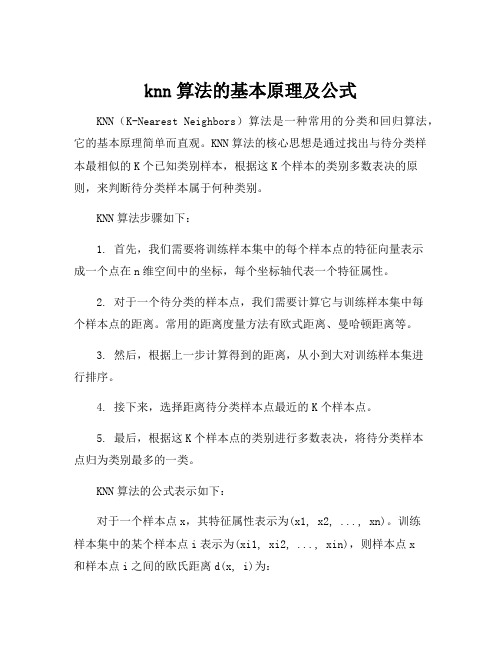
knn算法的基本原理及公式KNN(K-Nearest Neighbors)算法是一种常用的分类和回归算法,它的基本原理简单而直观。
KNN算法的核心思想是通过找出与待分类样本最相似的K个已知类别样本,根据这K个样本的类别多数表决的原则,来判断待分类样本属于何种类别。
KNN算法步骤如下:1. 首先,我们需要将训练样本集中的每个样本点的特征向量表示成一个点在n维空间中的坐标,每个坐标轴代表一个特征属性。
2. 对于一个待分类的样本点,我们需要计算它与训练样本集中每个样本点的距离。
常用的距离度量方法有欧式距离、曼哈顿距离等。
3. 然后,根据上一步计算得到的距离,从小到大对训练样本集进行排序。
4. 接下来,选择距离待分类样本点最近的K个样本点。
5. 最后,根据这K个样本点的类别进行多数表决,将待分类样本点归为类别最多的一类。
KNN算法的公式表示如下:对于一个样本点x,其特征属性表示为(x1, x2, ..., xn)。
训练样本集中的某个样本点i表示为(xi1, xi2, ..., xin),则样本点x和样本点i之间的欧氏距离d(x, i)为:d(x, i) = √((x1 - xi1)^2 + (x2 - xi2)^2 + ... + (xn - xin)^2)找出距离样本点x最近的K个样本点后,根据多数表决原则,可将样本点x归为其中样本类别最多的一类。
KNN算法的特点是简单易于理解,适用于多种领域的分类问题。
它没有明确的训练过程,只需要保存训练样本集,因此训练时间很短,预测效率较高。
但是,KNN算法在处理大规模数据集时,计算距离的复杂度较高,需要耗费较多的计算资源。
另外,KNN算法对数据集中的噪声和异常值比较敏感,需要进行数据预处理和特征选择。
总的来说,KNN算法是一种简单但有效的分类方法。
通过寻找与待分类样本最相似的K个已知类别样本,它可以进行准确的分类和回归预测。
在实际应用中,可以根据具体的需求和问题特点,选择合适的K 值和距离度量方法,以获得更好的分类性能。
机器学习10大经典算法

机器学习10大经典算法机器学习是指通过计算机算法从大量数据中获取知识或经验,用于模拟人类的学习能力和决策过程。
在机器学习领域中,有许多经典的算法被广泛应用于各种任务,包括分类、聚类、回归等。
下面将介绍机器学习领域中的十大经典算法。
1. 线性回归(Linear Regression):线性回归是最基础的机器学习算法之一,用于建立输入变量和输出变量之间的线性关系。
通过拟合一条最佳拟合直线,来预测新的输入数据的输出值。
2. 逻辑回归(Logistic Regression):逻辑回归用于处理二分类问题,通过拟合一个Sigmoid函数来预测新的输入数据的输出概率。
逻辑回归比较简单且计算速度快,是许多实际问题中的常用算法。
3. 决策树(Decision Tree):决策树是一种基于树状结构的分类算法,通过一系列的选择和分割策略将输入数据进行分类或者回归。
决策树易于理解和解释,并且在处理非线性关系的问题时表现良好。
4. 随机森林(Random Forest):随机森林是一种集成学习方法,通过组合多个决策树进行分类和回归。
随机森林能够解决决策树容易过拟合的问题,并且在处理大规模数据时具有较高的效率和准确度。
5. 支持向量机(Support Vector Machine):支持向量机是一种常用的二分类算法,通过将样本数据映射到高维特征空间,并在该空间中寻找一个最优超平面来进行分类。
支持向量机在处理线性和非线性问题时表现出色。
7. 朴素贝叶斯(Naive Bayes):朴素贝叶斯是一种基于概率统计的分类算法,它假设特征之间是相互独立的。
该算法通过计算给定特征的条件概率,来对新的输入数据进行分类。
8. K均值聚类(K-Means Clustering):K均值聚类是一种无监督学习算法,通过将数据点分为K个簇,使得簇内的数据点相似度较高,而簇间的相似度较低。
K均值聚类适用于处理大规模数据和寻找数据内在结构的问题。
9. 神经网络(Neural Networks):神经网络是一种模拟生物神经系统的机器学习模型,由多层神经元相互连接而成。
10 大常用机器学习算法,包括线性回归、Logistic 回归、线性判别分析、朴素贝叶斯、KNN、随机森林等

1.线性回归在统计学和机器学习领域,线性回归可能是最广为人知也最易理解的算法之一。
预测建模主要关注的是在牺牲可解释性的情况下,尽可能最小化模型误差或做出最准确的预测。
我们将借鉴、重用来自许多其它领域的算法(包括统计学)来实现这些目标。
线性回归模型被表示为一个方程式,它为输入变量找到特定的权重(即系数 B),进而描述一条最佳拟合了输入变量(x)和输出变量(y)之间关系的直线。
我们将在给定输入值 x的条件下预测 y,线性回归学习算法的目的是找到系数 B0 和 B1 的值。
我们可以使用不同的技术来从数据中学习线性回归模型,例如普通最小二乘法的线性代数解和梯度下降优化。
线性回归大约有 200 多年的历史,并已被广泛地研究。
在使用此类技术时,有一些很好的经验规则:我们可以删除非常类似(相关)的变量,并尽可能移除数据中的噪声。
线性回归是一种运算速度很快的简单技术,也是一种适合初学者尝试的经典算法。
2. Logist ic回归Logis t ic回归是机器学习从统计学领域借鉴过来的另一种技术。
它是二分类问题的首选方法。
像线性回归一样, Log is t ic回归的目的也是找到每个输入变量的权重系数值。
但不同的是,Logis t ic回归的输出预测结果是通过一个叫作「log is t ic函数」的非线性函数变换而来的。
log is t ic函数的形状看起来像一个大的「 S」,它会把任何值转换至 0-1 的区间内。
这十分有用,因为我们可以把一个规则应用于log is t ic函数的输出,从而得到 0-1区间内的捕捉值(例如,将阈值设置为 0.5,则如果函数值小于 0.5,则输出值为 1),并预测类别的值。
Logis t ic由于模型的学习方式,Logis t i c回归的预测结果也可以用作给定数据实例属于类 0 或类 1的概率。
这对于需要为预测结果提供更多理论依据的问题非常有用。
与线性回归类似,当删除与输出变量无关以及彼此之间非常相似(相关)的属性后, Log is t ic回归的效果更好。
大数据十大经典算法kNN讲解
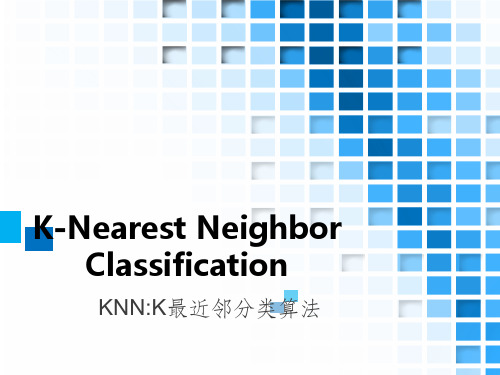
KNN:K最近邻分类算法
KNN算法怎么来的?
.
KNN算法是怎么来的
猜猜看:最后一行未知电影属于什么类型的电影。
电影名称 California Man
打斗次数 3
He’s Not Really
into Dudes
2
Beautiful Woman 1 Kevin Longblade 101
.
最近邻算法
提供一种思路,即:未知的豆离 哪种豆最近就认为未知豆和该豆是同一 种类。由此,我们引出最近邻算法的定 义:为了判定未知样本的类别,以全部 训练样本作为代表点,计算未知样本与 所有训练样本的距离,并以最近邻者的 类别作为决策未知样本类别的唯一依据。 但是,最近邻算法明显是存在缺陷的, 我们来看一个例子。
.
KNN算法的具体实现
由上面的例子可见:该算法在分类时有个重要的 不足是,当样本不平衡时,即:一个类的样本容量很大, 而其他类样本数量很小时,很有可能导致当输入一个未 知样本时,该样本的K个邻居中大数量类的样本占多数。 但是这类样本并不接近目标样本,而数量小的这类样本 很靠近目标样本。这个时候,我们有理由认为该位置样 本属于数量小的样本所属的一类,但是,KNN却不关心 这个问题,它只关心哪类样本的数量最多,而不去把距 离远近考虑在内,因此,我们可以采用权值的方法来改 进。和该样本距离小的邻居权值大,和该样本距离大的 邻居权值则相对较小,由此,将距离远近的因素也考虑 在内,避免因一个样本过大导致误判的情况。
.
KNN算法的改进:压缩近邻算法
利用现在的样本集,采取一定的算法产生一个新的样本 集,该样本集拥有比原样本集少的多的样本数量,但仍然保持 有对未知样本进行分类的能力。
knn算法的原理和步骤

knn算法的原理和步骤KNN(K-Nearest Neighbors)算法是一种基于实例的机器学习算法,它主要用于分类和回归问题。
在分类问题中,它通过找到某个数据点的K个最近邻居来预测该数据点的分类标签;在回归问题中,它通过找到某个数据点的K个最近邻居来预测该数据点的数值型输出。
KNN算法的原理和步骤如下:原理:KNN算法的核心思想是基于距离度量进行分类。
具体来说,对于给定的测试实例,KNN算法会在训练集中找到与该测试实例最近的K个训练实例,然后根据这K个训练实例的标签来预测测试实例的标签。
对于分类问题,通常采用“多数表决”的方式来决定预测标签;对于回归问题,通常采用“平均值”的方式来决定预测输出。
步骤:1. 确定K值:首先需要确定K值,即选择与测试实例距离最近的K个邻居。
K 值的选择会影响到模型的预测性能,通常通过交叉验证等方法进行选择。
2. 计算距离:对于每个测试实例,需要计算它与训练集中每个实例之间的距离。
常见的距离度量方法包括欧式距离、曼哈顿距离、闵可夫斯基距离等。
3. 找到K个最近邻居:根据计算出的距离,找到与测试实例距离最近的K个训练实例。
4. 预测标签或输出:对于分类问题,通过多数表决的方式确定测试实例的标签;对于回归问题,通过计算K个最近邻居的平均值来预测测试实例的输出。
5. 模型评估:最后需要对模型进行评估,通常采用交叉验证等方法进行评估,以判断模型的泛化能力和预测性能。
总之,KNN算法是一种简单但有效的机器学习算法,具有较好的准确性和可解释性,但也存在一些缺点,如需要大量的计算资源和存储空间,对离群点敏感等。
因此,在实际应用中需要仔细考虑算法的优缺点,选择合适的算法并对其进行优化。
机器学习算法中的KNN算法详解

机器学习算法中的KNN算法详解随着人工智能领域的不断发展,机器学习算法作为其中的重要组成部分,越来越受到关注。
其中KNN算法作为一种经典的分类算法,在实际应用中也被广泛使用。
本文将对KNN算法进行详细介绍,包括算法原理、应用场景、实现过程等方面的内容。
一、算法概述KNN算法全称为K-Nearest Neighbor算法,它是一种常用的非参数化分类算法,最初由Cover和Hart在1967年提出。
简单来说,该算法的核心思想是根据已知数据的类别,通过计算新数据点与已知数据之间的距离,找到和新数据最相似的K个数据点,然后根据这K个数据点的类别进行分类。
二、算法原理在KNN算法中,通过计算不同数据点之间的距离来判断它们之间的相似性。
常用的距离度量方式有欧氏距离、曼哈顿距离、切比雪夫距离等。
其中欧氏距离是最常用的一种方式,它的计算公式如下:$$d(x,y)=\sqrt{\sum_{i=1}^{n}(x_i-y_i)^2}$$其中,x和y分别为两个数据点,n为它们的特征数。
然后根据计算得到的距离,找到距离最近的K个数据点,这些数据点被称为“邻居”。
最后根据这K个邻居的类别,选择出现次数最多的那个类别作为待分类数据点的类别。
在分析KNN算法的时候,需要考虑以下两个要素:1.怎样衡量两个点之间的距离。
2.怎样选择K值。
三、应用场景KNN算法在实际应用中有很广泛的应用。
例如在地图上选择交通最便捷的路线、医学上判断疾病的诊断、金融上客户信用评估等。
由于该算法无需对数据进行假设或者设置参数,所以在解决非线性问题上面的效果比较好。
四、算法实践在代码实践中,可以使用Python语言编写KNN算法。
下面是一段使用Python实现的简单KNN算法的代码。
```import numpy as npimport operatordef classify(input_data, data_set, labels, k):data_set_size = data_set.shape[0]diff_mat = np.tile(input_data, (data_set_size, 1)) - data_setsq_diff_mat = diff_mat ** 2sq_distances = sq_diff_mat.sum(axis=1)distances = sq_distances ** 0.5sorted_dist_indicies = distances.argsort()class_count = {}for i in range(k):vote_label = labels[sorted_dist_indicies[i]]class_count[vote_label] = class_count.get(vote_label, 0) + 1sorted_class_count = sorted(class_count.items(),key=operator.itemgetter(1), reverse=True)return sorted_class_count[0][0]```以上代码中的classify函数,就是KNN算法的核心实现过程。
10种机器学习算法介绍

线性回归
针对线性回归容易出现欠拟合的问题,采取局部加权线性回归。
在该算法中,赋予预测点附近每一个点以一定的权值,在这上面基于波长函数来进行普通的线
性回归.可以实现对临近点的精确拟合同时忽略那些距离较远的点的贡献,即近点的权值大,远 点的权值小,k为波长参数,控制了权值随距离下降的速度,越大下降的越快。
缺点:
(1) SVM算法对大规模训练样本难以实施
(2) 用SVM解决多分类问题存在困难
经典的支持向量机算法只给出了二类分类的算法,而在数据挖掘的实际应用中,一般要解决多类 的分类问题。
朴素贝叶斯
#Import Library from sklearn.naive_bayes import GaussianNB #Assumed you have, X (predictor) and Y (target) for training data set and x_test(predictor) of test_dataset # Create SVM classification object model = GaussianNB() # there is other distribution for multinomial classes like Bernoulli Naive Bayes, Refer link # Train the model using the training sets and check score model.fit(X, y) #Predict Output predicted= model.predict(x_test)
终止树
(1)节点达到完全纯性; (2)树的深度达到用户指定的深度; (3)节点中样本的个数少于用户指定的个数; (4) 异质性指标下降的最大幅度小于用户指定的幅度。
人工智能和机器学习中的分类算法应用
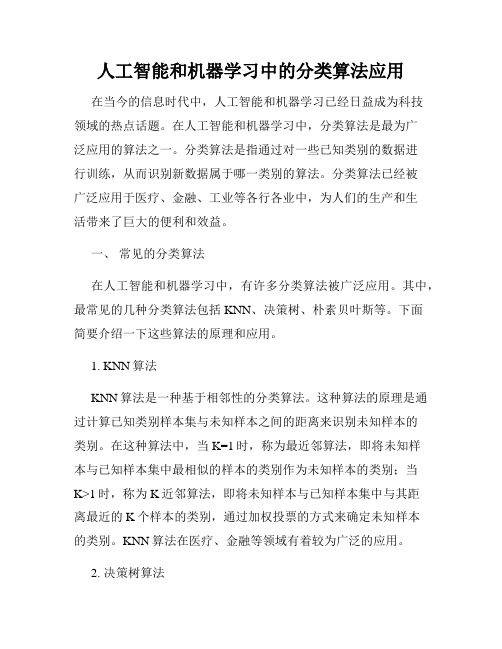
人工智能和机器学习中的分类算法应用在当今的信息时代中,人工智能和机器学习已经日益成为科技领域的热点话题。
在人工智能和机器学习中,分类算法是最为广泛应用的算法之一。
分类算法是指通过对一些已知类别的数据进行训练,从而识别新数据属于哪一类别的算法。
分类算法已经被广泛应用于医疗、金融、工业等各行各业中,为人们的生产和生活带来了巨大的便利和效益。
一、常见的分类算法在人工智能和机器学习中,有许多分类算法被广泛应用。
其中,最常见的几种分类算法包括KNN、决策树、朴素贝叶斯等。
下面简要介绍一下这些算法的原理和应用。
1. KNN算法KNN算法是一种基于相邻性的分类算法。
这种算法的原理是通过计算已知类别样本集与未知样本之间的距离来识别未知样本的类别。
在这种算法中,当K=1时,称为最近邻算法,即将未知样本与已知样本集中最相似的样本的类别作为未知样本的类别;当K>1时,称为K近邻算法,即将未知样本与已知样本集中与其距离最近的K个样本的类别,通过加权投票的方式来确定未知样本的类别。
KNN算法在医疗、金融等领域有着较为广泛的应用。
2. 决策树算法决策树算法是一种基于树形结构的分类算法。
这种算法的原理是通过将样本集拆分成更小的子集,直到所有子集中的样本属于同一类别,从而得到一棵决策树。
在这种算法中,每个节点表示一个属性测试,每个分支代表一个测试输出,每个叶子节点代表一种类别。
决策树算法在金融、工业等领域有着广泛的应用。
3. 朴素贝叶斯算法朴素贝叶斯算法是一种基于概率的分类算法。
这种算法的原理是通过计算给定数据点的特征值,属于每个可能类别的概率来确定数据点的类别。
在这种算法中,朴素贝叶斯假设所有特征是彼此独立的,并且拥有相同的概率分布,这种假设使得算法具有较好的计算性能。
朴素贝叶斯算法在文本分类、垃圾邮件过滤等领域有着广泛的应用。
二、分类算法在不同领域的应用在不同的领域中,分类算法有着不同的应用和作用。
下面以医疗、金融、工业等领域为例,简要介绍一下分类算法在这些领域的应用情况。
- 1、下载文档前请自行甄别文档内容的完整性,平台不提供额外的编辑、内容补充、找答案等附加服务。
- 2、"仅部分预览"的文档,不可在线预览部分如存在完整性等问题,可反馈申请退款(可完整预览的文档不适用该条件!)。
- 3、如文档侵犯您的权益,请联系客服反馈,我们会尽快为您处理(人工客服工作时间:9:00-18:30)。
Chapter8k NN:k-Nearest NeighborsMichael Steinbach and Pang-Ning TanContents8.1Introduction (151)8.2Description of the Algorithm (152)8.2.1High-Level Description (152)8.2.2Issues (153)8.2.3Software Implementations (155)8.3Examples (155)8.4Advanced Topics (157)8.5Exercises (158)Acknowledgments (159)References (159)8.1IntroductionOne of the simplest and rather trivial classifiers is the Rote classifier,which memorizes the entire training data and performs classification only if the attributes of the test object exactly match the attributes of one of the training objects.An obvious problem with this approach is that many test records will not be classified because they do not exactly match any of the training records.Another issue arises when two or more training records have the same attributes but different class labels.A more sophisticated approach,k-nearest neighbor(k NN)classification[10,11,21],finds a group of k objects in the training set that are closest to the test object,and bases the assignment of a label on the predominance of a particular class in this neighborhood.This addresses the issue that,in many data sets,it is unlikely that one object will exactly match another,as well as the fact that conflicting information about the class of an object may be provided by the objects closest to it.There are several key elements of this approach:(i)the set of labeled objects to be used for evaluating a test object’s class,1(ii)a distance or similarity metric that can be used to computeThis need not be the entire training set.151152kNN:k-Nearest Neighborsthe closeness of objects,(iii)the value of k,the number of nearest neighbors,and(iv) the method used to determine the class of the target object based on the classes and distances of the k nearest neighbors.In its simplest form,k NN can involve assigning an object the class of its nearest neighbor or of the majority of its nearest neighbors, but a variety of enhancements are possible and are discussed below.More generally,k NN is a special case of instance-based learning[1].This includes case-based reasoning[3],which deals with symbolic data.The k NN approach is also an example of a lazy learning technique,that is,a technique that waits until the query arrives to generalize beyond the training data.Although k NN classification is a classification technique that is easy to understand and implement,it performs well in many situations.In particular,a well-known result by Cover and Hart[6]shows that the classification error2of the nearest neighbor rule is bounded above by twice the optimal Bayes error3under certain reasonable assump-tions.Furthermore,the error of the general k NN method asymptotically approaches that of the Bayes error and can be used to approximate it.Also,because of its simplicity,k NN is easy to modify for more complicated classifi-cation problems.For instance,k NN is particularly well-suited for multimodal classes4 as well as applications in which an object can have many class labels.To illustrate the last point,for the assignment of functions to genes based on microarray expression profiles,some researchers found that k NN outperformed a support vector machine (SVM)approach,which is a much more sophisticated classification scheme[17]. The remainder of this chapter describes the basic k NN algorithm,including vari-ous issues that affect both classification and computational performance.Pointers are given to implementations of k NN,and examples of using the Weka machine learn-ing package to perform nearest neighbor classification are also provided.Advanced techniques are discussed briefly and this chapter concludes with a few exercises. 8.2Description of the Algorithm8.2.1High-Level DescriptionAlgorithm8.1provides a high-level summary of the nearest-neighbor classification method.Given a training set D and a test object z,which is a vector of attribute values and has an unknown class label,the algorithm computes the distance(or similarity)2The classification error of a classifier is the percentage of instances it incorrectly classifies.3The Bayes error is the classification error of a Bayes classifier,that is,a classifier that knows the underlying probability distribution of the data with respect to class,and assigns each data point to the class with the highest probability density for that point.For more detail,see[9].4With multimodal classes,objects of a particular class label are concentrated in several distinct areas of the data space,not just one.In statistical terms,the probability density function for the class does not have a single“bump”like a Gaussian,but rather,has a number of peaks.8.2Description of the Algorithm 153Algorithm 8.1Basic k NN AlgorithmInput :D ,the set of training objects,the test object,z ,which is a vector ofattribute values,and L ,the set of classes used to label the objectsOutput :c z ∈L ,the class of z foreach object y ∈D do|Compute d (z ,y ),the distance between z and y ;endSelect N ⊆D ,the set (neighborhood)of k closest training objects for z ;c z =argmax v ∈Ly ∈N I (v =class (c y ));where I (·)is an indicator function that returns the value 1if its argument is true and 0otherwise.between z and all the training objects to determine its nearest-neighbor list.It then assigns a class to z by taking the class of the majority of neighboring objects.Ties are broken in an unspecified manner,for example,randomly or by taking the most frequent class in the training set.The storage complexity of the algorithm is O (n ),where n is the number of training objects.The time complexity is also O (n ),since the distance needs to be computed between the target and each training object.However,there is no time taken for the construction of the classification model,for example,a decision tree or sepa-rating hyperplane.Thus,k NN is different from most other classification techniques which have moderately to quite expensive model-building stages,but very inexpensive O (constant )classification steps.8.2.2IssuesThere are several key issues that affect the performance of k NN.One is the choice of k .This is illustrated in Figure 8.1,which shows an unlabeled test object,x ,and training objects that belong to either a “+”or “−”class.If k is too small,then the result can be sensitive to noise points.On the other hand,if k is too large,then the neighborhood may include too many points from other classes.An estimate of the best value for k can be obtained by cross-validation.However,it is important to point out that k =1may be able to perform other values of k ,particularly for small data sets,including those typically used in research or for class exercises.However,given enough samples,larger values of k are more resistant to noise.Another issue is the approach to combining the class labels.The simplest method is to take a majority vote,but this can be a problem if the nearest neighbors vary widely in their distance and the closer neighbors more reliably indicate the class of the object.A more sophisticated approach,which is usually much less sensitive to the choice of k ,weights each object’s vote by its distance.Various choices are possible;for example,the weight factor is often taken to be the reciprocal of the squared distance:w i =1/d (y ,z )2.This amounts to replacing the last step of Algorithm 8.1with the154kNN:k-Nearest Neighbors ++‒‒‒‒‒‒‒‒‒‒‒‒‒‒‒‒‒‒‒‒+++X ++++++‒‒‒‒‒‒‒‒‒‒‒‒‒‒‒‒‒‒‒‒‒+++++++++++X ‒‒‒‒‒‒‒‒‒‒‒‒‒‒‒‒‒‒‒‒‒+++++++++++X (a) Neighborhood toosmall.(b) Neighborhood just right.(c) Neighborhood too large.Figure 8.1k -nearest neighbor classification with small,medium,and large k .following:Distance-Weighted V oting:c z =argmax v ∈L y ∈N w i ×I (v =class (c y ))(8.1)The choice of the distance measure is another important monly,Euclidean or Manhattan distance measures are used [21].For two points,x and y ,with n attributes,these distances are given by the following formulas:d (x ,y )= n k =1(x k −y k )2Euclidean distance (8.2)d (x ,y )= n k =1|x k −y k |Manhattan distance (8.3)where x k and y k are the k th attributes (components)of x and y ,respectively.Although these and various other measures can be used to compute the distance between two points,conceptually,the most desirable distance measure iswhich a smaller distance between two objects implies a greater likelihood the same class.Thus,for example,if k NN is being applied to classify it may be better to use the cosine measure rather than Euclidean distance.k NN can also be used for data with categorical or mixed categorical and numerical attributes as long as a suitable distance measure can be defined [21].Some distance measures can also be affected by the high dimensionality of the data.In particular,it is well known that the Euclidean distance measure becomes less discriminating as the number of attributes increases.Also,attributes may have to be scaled to prevent distance measures from being dominated by one of the attributes.For example,consider a data set where the height of a person varies from 1.5to 1.8m,8.3Examples155 the weight of a person varies from90to300lb,and the income of a person varies from$10,000to$1,000,000.If a distance measure is used without scaling,the income attribute will dominate the computation of distance,and thus the assignment of class labels.8.2.3Software ImplementationsAlgorithm8.1is easy to implement in almost any programming language.However, this section contains a short guide to some readily available implementations of this algorithm and its variants for those who would rather use an existing implementation. One of the most readily available k NN implementations can be found in Weka[26]. The main function of interest is IBk,which is basically Algorithm8.1.However,IBk also allows you to specify a couple of choices of distance weighting and the option to determine a value of k by using cross-validation.Another popular nearest neighbor implementation is PEBLS(Parallel Exemplar-Based Learning System)[5,19]from the CMU Artificial Intelligence repository[20]. According to the site,“PEBLS(Parallel Exemplar-Based Learning System)is a nearest-neighbor learning system designed for applications where the instances have symbolic feature values.”8.3ExamplesIn this section we provide a couple of examples of the use of k NN.For these examples, we will use the Weka package described in the previous section.Specifically,we used Weka3.5.6.To begin,we applied k NN to the Iris data set that is available from the UCI Machine Learning Repository[2]and is also available as a sample datafile with Weka.This data set consists of150flowers split equally among three Iris species:Setosa,Versicolor, and Virginica.Eachflower is characterized by four measurements:petal length,petal width,sepal length,and sepal width.The Iris data set was classified using the IB1algorithm,which corresponds to the IBk algorithm with k=1.In other words,the algorithm looks at the closest neighbor, as computed using Euclidean distance from Equation8.2.The results are quite good, as the reader can see by examining the confusion matrix5given in Table8.1. However,further investigation shows that this is a quite easy data set to classify since the different species are relatively well separated in the data space.To illustrate, we show a plot of the data with respect to petal length and petal width in Figure8.2. There is some mixing between the Versicolor and Virginica species with respect to 5A confusion matrix tabulates how the actual classes of various data instances(rows)compare to their predicted classes(columns).156kNN:k-Nearest NeighborsTABLE 8.1Confusion Matrix for Weka k NNClassifier IB1on the Iris Data SetActual/Predicted Setosa Versicolor Virginica Setosa5000Versicolor0473Virginica 0446their petal lengths and widths,but otherwise the species are well separated.Since the other two variables,sepal width and sepal length,add little if any discriminating information,the performance seen with basic k NN approach is about the best that can be achieved with a k NN approach or,indeed,any other approach.The second example uses the ionosphere data set from UCI.The data objects in this data set are radar signals sent into the ionosphere and the class value indicates whether or not the signal returned information on the structure of the ionosphere.There are 34attributes that describe the signal and 1class attribute.The IB1algorithm applied on the original data set gives an accuracy of 86.3%evaluated via tenfold cross-validation,while the same algorithm applied to the first nine attributes gives an accuracy of 89.4%.In other words,using fewer attributes gives better results.The confusion matrices are given ing cross-validation to select the number of nearest neighbors gives an accuracy of 90.8%with two nearest neighbors.The confusion matrices for these cases are given below in Tables 8.2,8.3,and 8.4,respectively.Adding weighting for nearest neighbors actually results in a modest drop in accuracy.The biggest improvement is due to reducing the number of attributes.P e t a l w i d t h Petal lengthFigure 8.2Plot of Iris data using petal length and width.8.4Advanced Topics157TABLE8.2Confusion Matrix for Weka k NN ClassifierIB1on the Ionosphere Data Set Using All AttributesActual/Predicted Good Signal Bad SignalGood Signal8541Bad Signal72188.4Advanced TopicsTo address issues related to the distance function,a number of schemes have been developed that try to compute the weights of each individual attribute or in some other way determine a more effective distance metric based upon a training set[13,15]. In addition,weights can be assigned to the training objects themselves.This can give more weight to highly reliable training objects,while reducing the impact of unreliable objects.The PEBLS system by Cost and Salzberg[5]is a well-known example of such an approach.As mentioned,k NN classifiers are lazy learners,that is,models are not built explic-itly unlike eager learners(e.g.,decision trees,SVM,etc.).Thus,building the model is cheap,but classifying unknown objects is relatively expensive since it requires the computation of the k-nearest neighbors of the object to be labeled.This,in general, requires computing the distance of the unlabeled object to all the objects in the la-beled set,which can be expensive particularly for large training sets.A number of techniques,e.g.,multidimensional access methods[12]or fast approximate similar-ity search[16],have been developed for efficient computation of k-nearest neighbor distance that make use of the structure in the data to avoid having to compute distance to all objects in the training set.These techniques,which are particularly applicable for low dimensional data,can help reduce the computational cost without affecting classification accuracy.The Weka package provides a choice of some of the multi-dimensional access methods in its IBk routine.(See Exercise4.)Although the basic k NN algorithm and some of its variations,such as weighted k NN and assigning weights to objects,are relatively well known,some of the more advanced techniques for k NN are much less known.For example,it is typically possible to eliminate many of the stored data objects,but still retain the classification accuracy of the k NN classifier.This is known as“condensing”and can greatly speed up the classification of new objects[14].In addition,data objects can be removed to TABLE8.3Confusion Matrix for Weka k NN ClassifierIB1on the Ionosphere Data Set Using the First Nine AttributesActual/Predicted Good Signal Bad SignalGood Signal10026Bad Signal11214158kNN:k-Nearest NeighborsTABLE8.4Confusion Matrix for Weka k NNClassifier IBk on the Ionosphere Data Set Usingthe First Nine Attributes with k=2Actual/Predicted Good Signal Bad SignalGood Signal1039Bad Signal23216improve classification accuracy,a process known as“editing”[25].There has also been a considerable amount of work on the application of proximity graphs(nearest neighbor graphs,minimum spanning trees,relative neighborhood graphs,Delaunay triangulations,and Gabriel graphs)to the k NN problem.Recent papers by Toussaint [22–24],which emphasize a proximity graph viewpoint,provide an overview of work addressing these three areas and indicate some remaining open problems.Other important resources include the collection of papers by Dasarathy[7]and the book by Devroye,Gyorfi,and Lugosi[8].Also,a fuzzy approach to k NN can be found in the work of Bezdek[4].Finally,an extensive bibliography on this subject is also available online as part of the Annotated Computer Vision Bibliography[18].8.5Exercises1.Download the Weka machine learning package from the Weka project home-page and the Iris and ionosphere data sets from the UCI Machine Learning Repository.Repeat the analyses performed in this chapter.2.Prove that the error of the nearest neighbor rule is bounded above by twice theBayes error under certain reasonable assumptions.3.Prove that the error of the general k NN method asymptotically approaches thatof the Bayes error and can be used to approximate it.4.Various spatial or multidimensional access methods can be used to speed upthe nearest neighbor computation.For the k-d tree,which is one such method, estimate how much the saving would ment:The IBk Weka classification algorithm allows you to specify the method offinding nearest neighbors.Try this on one of the larger UCI data sets,for example,predicting sex on the abalone data set.5.Consider the one-dimensional data set shown in Table8.5.TABLE8.5Data Set for Exercise5x 1.5 2.5 3.5 4.5 5.0 5.5 5.75 6.57.510.5y++−−−++−++References159(a)Given the data points listed in Table8.5,compute the class of x=5.5according to its1-,3-,6-,and9-nearest neighbors(using majority vote).(b)Repeat the previous exercise,but use the weighted version of k NN givenin Equation(8.1).ment on the use of k NN when documents are compared with the cosinemeasure,which is a measure of similarity,not distance.7.Discuss kernel density estimation and its relationship to k NN.8.Given an end user who desires not only a classification of unknown cases,butalso an understanding of why cases were classified the way they were,which classification method would you prefer:decision tree or k NN?9.Sampling can be used to reduce the number of data points in many kinds ofdata ment on the use of sampling for k NN.10.Discuss how k NN could be used to perform classification when each class canhave multiple labels and/or classes are organized in a hierarchy.AcknowledgmentsThis work was supported by NSF Grant CNS-0551551,NSF ITR Grant ACI-0325949, NSF Grant IIS-0308264,and NSF Grant IIS-0713227.Access to computing facil-ities was provided by the University of Minnesota Digital Technology Center and Supercomputing Institute.References[1] D.W.Aha,D.Kibler,and M.K.Albert.Instance-based learning algorithms.Mach.Learn.,6(1):37–66,January1991.[2] A.Asuncion and D.Newman.UCI Machine Learning Repository,2007.[3] B.Bartsch-Sp¨o rl,M.Lenz,and A.H¨u bner.Case-based reasoning—surveyand future directions.In F.Puppe,editor,XPS-99:Knowledge-Based Systems—Survey and Future Directions,5th Biannual German Conference on Knowledge-Based Systems,volume1570of Lecture Notes in Computer Sci-ence,W¨u rzburg,Germany,March3-51999.Springer.[4]J.C.Bezdek,S.K.Chuah,and D.Leep.Generalized k-nearest neighbor rules.Fuzzy Sets Syst.,18(3):237–256,1986.[5]S.Cost and S.Salzberg.A weighted nearest neighbor algorithm for learningwith symbolic features.Mach.Learn.,10(1):57–78,1993.160kNN:k-Nearest Neighbors[6]T.Cover and P.Hart.Nearest neighbor pattern classification.IEEE Transactionson Information Theory,13(1):21–27,January1967.[7] B.Dasarathy.Nearest Neighbor(NN)Norms:NN Pattern Classification Tech-puter Society Press,1991.[8]L.Devroye,L.Gyorfi,and G.Lugosi.A Probabilistic Theory of Pattern Recog-nition.Springer-Verlag,1996.[9]R.O.Duda,P.E.Hart,and D.G.Stork.Pattern Classification(2nd Edition).Wiley-Interscience,November2000.[10] E.Fix and J.J.Hodges.Discriminatory analysis:Non-parametric discrimi-nation:Consistency properties.Technical report,USAF School of Aviation Medicine,1951.[11] E.Fix and J.J.Hodges.Discriminatory analysis:Non-parametric discrimina-tion:Small sample performance.Technical report,USAF School of Aviation Medicine,1952.[12]V.Gaede and O.G¨u nther.Multidimensional access methods.ACM Comput.Surv.,30(2):170–231,1998.[13] E.-H.Han,G.Karypis,and V.Kumar.Text categorization using weight adjustedk-nearest neighbor classification.In PAKDD’01:Proceedings of the5th Pacific-Asia Conference on Knowledge Discovery and Data Mining,pages53–65, London,UK,2001.Springer-Verlag.[14]P.Hart.The condensed nearest neighbor rule.IEEE rm.,14(5):515–516,May1968.[15]T.Hastie and R.Tibshirani.Discriminant adaptive nearest neighbor classifica-tion.IEEE Trans.Pattern Anal.Mach.Intell.,18(6):607–616,1996.[16]M.E.Houle and J.Sakuma.Fast approximate similarity search in extremelyhigh-dimensional data sets.In ICDE’05:Proceedings of the21st Interna-tional Conference on Data Engineering,pages619–630,Washington,DC, 2005.IEEE Computer Society.[17]M.Kuramochi and G.Karypis.Gene classification using expression profiles:A feasibility study.In BIBE’01:Proceedings of the2nd IEEE InternationalSymposium on Bioinformatics and Bioengineering,page191,Washington,DC, 2001.IEEE Computer Society.[18]K.Price.Nearest neighbor classification bibliography.http://www.visionbib.com/bibliography/pattern621.html,2008.Part of the Annotated Computer Vision Bibliography.[19]J.Rachlin,S.Kasif,S.Salzberg,and D.W.Aha.Towards a better understandingof memory-based reasoning systems.In International Conference on Machine Learning,pages242–250,1994.References161 [20]S.Salzberg.PEBLS:Parallel exemplar-based learning system.http://www./afs/cs/project/ai-repository/ai/areas/learning/systems/pebls/0.html, 1994.[21]P.-N.Tan,M.Steinbach,and V.Kumar.Introduction to Data Minining.PearsonAddison-Wesley,2006.[22]G.T.Toussaint.Proximity graphs for nearest neighbor decision rules:Recentprogress.In Interface-2002,34th Symposium on Computing and Statistics, Montreal,Canada,April17–20,2002.[23]G.T.Toussaint.Open problems in geometric methods for instance-based learn-ing.In Discrete and Computational Geometry,volume2866of Lecture Notes in Computer Science,pages273–283,December6–9,2003.[24]G.T.Toussaint.Geometric proximity graphs for improving nearest neighbormethods in instance-based learning and data put.Geometry Appl.,15(2):101–150,2005.[25] D.Wilson.Asymptotic properties of nearest neighbor rules using edited data.IEEE Trans.Syst.,Man,and Cybernetics,2:408–421,1972.[26]I.H.Witten and E.Frank.Data Mining:Practical Machine Learning Tools andTechniques,Second Edition(Morgan Kaufmann Series in Data Management Systems).Morgan Kaufmann,June2005.© 2009 by Taylor & Francis Group, LLC。
